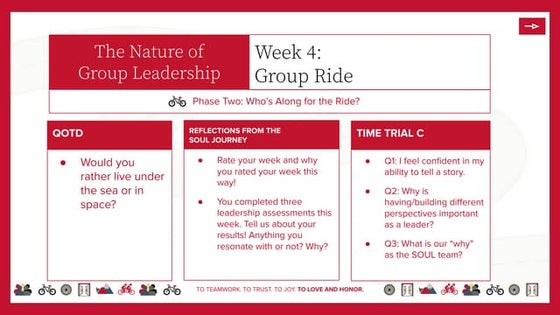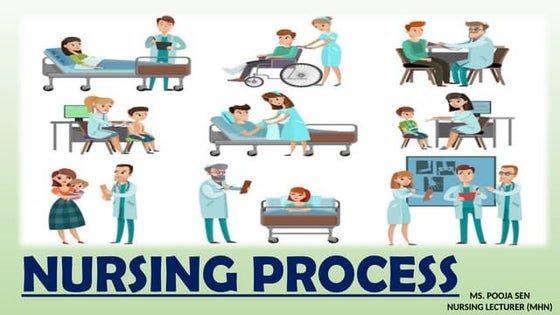Coding Guide Handout
Download as DOCX, PDF1 like220 views
Coding Guide used for a usability study of the California State University, Fresno Henry Madden Library web site by campus faculty.
1 of 1
Download to read offline
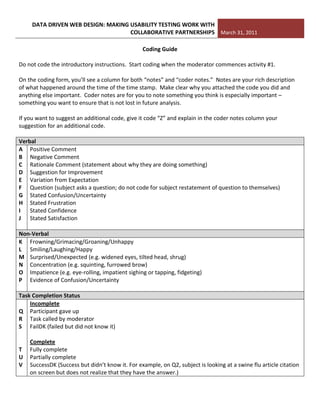
Recommended
The jesuit relations



The jesuit relations009025131
Ėý
The document provides an overview of the Jesuit Relations, which were annual publications by Jesuit missionaries describing their encounters with indigenous peoples in North America. It discusses their interactions with the Montagnais, Huron, and Iroquois tribes, including descriptions of their customs, beliefs, languages, and the Jesuits' efforts to convert them to Christianity. It also touches on how diseases spread differently among the tribes and the Jesuits' focus on medical isolation versus indigenous practices.Trivial answers



Trivial answersLaura Alcolado
Ėý
This document contains summaries of information from various categories including sports, history, and literature. In sports, it provides details on rugby team composition, the first Catalan basketball team to win the European Championship in 1993-94, and Chelsea's stadium location. In history, it summarizes Germany's invasion in 1939 starting World War 2, Winston Churchill as British prime minister during that war, and India's independence from Britain in 1947. For literature, it identifies Lord Voldemort as the evil character in Harry Potter, the subject of Miguel Hernandez's "Nanas de...", and the writer of novels like "David Copperfield" and "Oliver Twist".Grammartestmultiplechoice 130429073109-phpapp02



Grammartestmultiplechoice 130429073109-phpapp02Laura Alcolado
Ėý
This document contains a series of grammar questions testing various parts of speech and grammatical structures in English. It covers topics such as verbs, pronouns, prepositions, conditionals, modals, and more. The questions range from basic to more advanced levels of difficulty.

ArtÃculo Sobre EutanasiaSegundo AÃąo A Campeche
Ėý
Este documento discute la historia de la eutanasia y el juramento hipocrÃĄtico. Explica que HipÃģcrates separÃģ las funciones de curar y matar para los mÃĐdicos, con el mÃĐdico enfocado solo en curar. Sin embargo, con el aborto y los esfuerzos para legalizar la eutanasia, los mÃĐdicos han vuelto a asumir ambas funciones de curar y matar.

ApresentaçÃĢo1 porto santo1324658709
Ėý
O documento resume lendas e histÃģrias da Ilha do Porto Santo, incluindo a lenda dos Profetas que enganaram os habitantes, a crença de que o Rei D. SebastiÃĢo estaria escondido na ilha, e a lenda de que CristÃģvÃĢo Colombo visitava a praia da ilha, interrogando o horizonte.āđāļāļĢāļāļāļēāļĢāļ§āļąāļĒāļĢāļļāđāļāđķÄāļāļīāļČĻļĨāđāļēāļ2



āđāļāļĢāļāļāļēāļĢāļ§āļąāļĒāļĢāļļāđāļāđķÄāļāļīāļČĻļĨāđāļēāļ24LIFEYES
Ėý
āđāļāļĢāļāļāļēāļĢāļ§āļąāļĒāļĢāļļāđāļāđķÄāļāļīāļČĻļĨāđāļēāļ2

Seleccion colombia14juancho1946
Ėý
La SelecciÃģn de fÚtbol de Colombia representa a ese paÃs en competiciones internacionales y estÃĄ dirigida por la FederaciÃģn Colombiana de FÚtbol. Algunos de sus logros mÃĄs importantes son haber ganado la Copa AmÃĐrica en 2001 y haber quedado en el tercer lugar del Mundial Sub-20 en 2003. El documento tambiÃĐn resalta las carreras de importantes jugadores que han vestido la camiseta de la selecciÃģn colombiana como Valderrama, Willington Ortiz, Tino Asprilla, Arnoldo IguarÃĄn y Falcao GarcÃaUX STRAT USA 2017: Jim Kalbach, "Using Jobs To Be Done to Create High-Value P...



UX STRAT USA 2017: Jim Kalbach, "Using Jobs To Be Done to Create High-Value P...UX STRAT
Ėý
This document provides an overview of the Jobs To Be Done (JTBD) framework for understanding customer needs and designing products and services. It outlines a process for discovering, defining, designing, delivering, and developing value using JTBD, including exercises for formulating jobs, creating job maps, writing job stories, and speaking to the market in terms of jobs. The document emphasizes starting with customer goals and problems rather than solutions, and shifting perspective to see opportunities from the customer's point of view.NARA Records Management Training - MIST Instructional Design Project



NARA Records Management Training - MIST Instructional Design ProjectAmanda Dinscore
Ėý
This training was developed for NARA by a group of students in the Master's of Instructional Science and Technology (MIST) program at CSU Monterey Bay. Storyboard



StoryboardAmanda Dinscore
Ėý
This document outlines a storyboard for a website project about 8 famous London sites. The home page will feature hoverable images linking to subpages on each site and a map of locations. Subpages will provide overviews with text, video or audio about each site along with selected websites and books. Some sites may not be fully developed for this assignment. The home page will also include a signup form linking to results.1 librarian 1,400 freshmen



1 librarian 1,400 freshmenAmanda Dinscore
Ėý
The librarian worked with the English department at a large public university to develop library instruction for over 1,400 freshmen enrolled in the required First Year Writing Program each year. Through collaboration with instructors, the librarian created a blog and online tutorials to deliver library instruction, replacing some face-to-face classes. An assessment found that the new approach improved students' information literacy skills and increased interaction between students, instructors and the librarian. The librarian seeks feedback on how to improve the tutorials and increase instructor involvement further.ACRL 2011 Data-Driven Library Web Design



ACRL 2011 Data-Driven Library Web DesignAmanda Dinscore
Ėý
Presentation from a workshop given at ACRL 2011 conference, Data-Driven Library Web Design: Making Usability Testing Work with Collaborative PartnershipsResearch Plan Handout



Research Plan HandoutAmanda Dinscore
Ėý
The document outlines 11 steps for drafting a research plan to test user tasks on a library website, including: 1) creating a purpose statement and objectives; 2) identifying potential collaborators; 3) brainstorming user tasks and questions to measure task completion; 4) determining the study population; 5) considering room/technology/data capture needs; 6) developing scripts, instructions and training moderators; 7) pre-testing and refining; 8) conducting the test; 9) analyzing collected data; 10) communicating results; and 11) making revisions to the site based on findings.ACRL 2011 Workshop Info Handout



ACRL 2011 Workshop Info HandoutAmanda Dinscore
Ėý
This workshop will present on a library's web usability study conducted in collaboration with faculty and students from the Anthropology and Education Departments. Attendees will learn about designing research plans to assess needs, recruit collaborators, create test activities, determine sample sizes, identify costs, and interpret and communicate results. They will also view study video excerpts to refine coding techniques. Presentation materials and documents will be available online.âUsability Testing of a Library Web Site: Librarians and Anthropologists Work...



âUsability Testing of a Library Web Site: Librarians and Anthropologists Work...Amanda Dinscore
Ėý
The document summarizes a usability study conducted by librarians and anthropology students at California State University, Fresno to test their library website. They recruited 42 junior students to complete tasks on the website like finding books and articles while thinking aloud. The study found students had difficulties with tasks and the search functionality. It provided insights for redesigning the website to be less institutional and more content-rich. The collaboration between librarians and anthropologists allowed them to collect both quantitative and qualitative user data to improve the student experience.Anti-Fungal Agents.pptx Medicinal Chemistry III B. Pharm Sem VI



Anti-Fungal Agents.pptx Medicinal Chemistry III B. Pharm Sem VISamruddhi Khonde
Ėý
UNIT â IV
Antifungal agents:
Antifungal antibiotics: Amphotericin-B, Nystatin, Natamycin, Griseofulvin.
Synthetic Antifungal agents: Clotrimazole, Econazole, Butoconazole,
Oxiconazole Tioconozole, Miconazole*, Ketoconazole, Terconazole,
Itraconazole, Fluconazole, Naftifine hydrochloride, Tolnaftate*UTI Quinolones by Mrs. Manjushri Dabhade



UTI Quinolones by Mrs. Manjushri DabhadeDabhade madam Dabhade
Ėý
UTI quinolones by Mrs. Manjushri DabhadeDifferent perspectives on dugout canoe heritage of Soomaa.pdf



Different perspectives on dugout canoe heritage of Soomaa.pdfAivar Ruukel
Ėý
Sharing the story of haabjas to 1st-year students of the University of Tartu MA programme "Folkloristics and Applied Heritage Studies" and 1st-year students of the Erasmus Mundus Joint Master programme "Education in Museums & Heritage". EDL 290F Week 5 - Facing Headwinds and Hairpin Turns (2025).pdf



EDL 290F Week 5 - Facing Headwinds and Hairpin Turns (2025).pdfLiz Walsh-Trevino
Ėý
EDL 290F Week 5 - Facing Headwinds and Hairpin Turns (2025).pdfPass SAP C_C4H47_2503 in 2025 | Latest Exam Questions & Study Material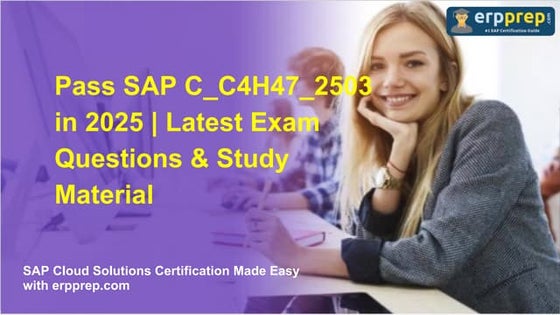



Pass SAP C_C4H47_2503 in 2025 | Latest Exam Questions & Study MaterialJenny408767
Ėý
Pass SAP C_C4H47_2503 with expert-designed practice tests & real questions. Start preparing today with ERPPrep.com and boost your SAP Sales Cloud career! Sulfonamides by Mrs. Manjushri P. Dabhade



Sulfonamides by Mrs. Manjushri P. DabhadeDabhade madam Dabhade
Ėý
Describe the information about classification, mechanism of action and chemical structures of sulfonamidesViceroys of India & Their Tenure â Key Events During British Rule



Viceroys of India & Their Tenure â Key Events During British RuleDeeptiKumari61
Ėý
The British Raj in India (1857-1947) saw significant events under various Viceroys, shaping the political, economic, and social landscape.
**Early Period (1856-1888):**
Lord Canning (1856-1862) handled the Revolt of 1857, leading to the British Crown taking direct control. Universities were established, and the Indian Councils Act (1861) was passed. Lord Lawrence (1864-1869) led the Bhutan War and established High Courts. Lord Lytton (1876-1880) enforced repressive laws like the Vernacular Press Act (1878) and Arms Act (1878) while waging the Second Afghan War.
**Reforms & Political Awakening (1880-1905):**
Lord Ripon (1880-1884) introduced the Factory Act (1881), Local Self-Government Resolution (1882), and repealed the Vernacular Press Act. Lord Dufferin (1884-1888) oversaw the formation of the Indian National Congress (1885). Lord Lansdowne (1888-1894) passed the Factory Act (1891) and Indian Councils Act (1892). Lord Curzon (1899-1905) introduced educational reforms but faced backlash for the Partition of Bengal (1905).
**Rise of Nationalism (1905-1931):**
Lord Minto II (1905-1910) saw the rise of the Swadeshi Movement and the Muslim League's formation (1906). Lord Hardinge II (1910-1916) annulled Bengalâs Partition (1911) and shifted Indiaâs capital to Delhi. Lord Chelmsford (1916-1921) faced the Lucknow Pact (1916), Jallianwala Bagh Massacre (1919), and Non-Cooperation Movement. Lord Reading (1921-1926) dealt with the Chauri Chaura Incident (1922) and the formation of the Swaraj Party. Lord Irwin (1926-1931) saw the Simon Commission protests, the Dandi March, and the Gandhi-Irwin Pact (1931).
**Towards Independence (1931-1947):**
Lord Willingdon (1931-1936) introduced the Government of India Act (1935), laying India's federal framework. Lord Linlithgow (1936-1944) faced WWII-related crises, including the Quit India Movement (1942). Lord Wavell (1944-1947) proposed the Cabinet Mission Plan (1946) and negotiated British withdrawal. Lord Mountbatten (1947-1948) oversaw India's Partition and Independence on August 15, 1947.
**Final Transition:**
C. Rajagopalachari (1948-1950), Indiaâs last Governor-General, facilitated Indiaâs transition into a republic before the position was abolished in 1950.
The British Viceroys played a crucial role in Indiaâs colonial history, introducing both repressive and progressive policies that fueled nationalist movements, ultimately leading to independence.https://www.youtube.com/@DKDEducationUrinary Tract Infection & Sexually Transmt ted Diseases.pptx



Urinary Tract Infection & Sexually Transmt ted Diseases.pptxAshish Umale
Ėý
This slides provide you the information regarding the sexually transmitted diseases as well as about the urinary tract infection. The presentation is based on the syllabus of Bachelor of Pharmacy semester 6 of subject name Pharmacology-III. The data is occupied from the high standard books and along with easy understanding of data. Design approaches and ethical challenges in Artificial Intelligence tools for...



Design approaches and ethical challenges in Artificial Intelligence tools for...Yannis
Ėý
The recent technology of Generative Artificial Intelligence (GenAI) has undeniable advantages, especially with regard to improving the efficiency of all stakeholders in the education process.
At the same time, almost all responsible international organisations and experts in the field of education and educational technology point out a multitude of general ethical problems that need to be addressed. Many of these problems have already arisen in previous models of artificial intelligence or even in systems based on learning data, and several are appearing for the first time.
In this short contribution, we will briefly review some dimensions of ethical problems, both (a) the general ones related to trust, transparency, privacy, personal data security, accountability, environmental responsibility, bias, power imbalance, etc., and (b) the more directly related to teaching, learning, and education, such as students' critical thinking, the social role of education, the development of teachers' professional competences, etc.
In addition, the categorizations of possible service allocation to humans and AI tools, the human-centered approach to designing AI tools and learning data, as well as the more general design of ethics-aware applications and activities will be briefly presented. Finally, some short illustrative examples will be presented to set the basis for the debate in relation to ethical and other dilemmas.U.S. Department of Education certification



U.S. Department of Education certificationMebane Rash
Ėý
Request to certify compliance with civil rights lawsStudying and Notetaking: Some Suggestions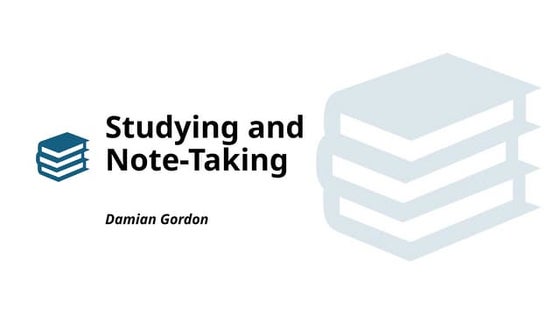



Studying and Notetaking: Some SuggestionsDamian T. Gordon
Ėý
Studying and Notetaking: Some SuggestionsGeneral Quiz at Maharaja Agrasen College | Amlan Sarkar | Prelims with Answer...



General Quiz at Maharaja Agrasen College | Amlan Sarkar | Prelims with Answer...Amlan Sarkar
Ėý
Prelims (with answers) + Finals of a general quiz originally conducted on 13th November, 2024.
Part of The Maharaja Quiz - the Annual Quiz Fest of Maharaja Agrasen College, University of Delhi.
Feedback welcome at amlansarkr@gmail.comMore Related Content
More from Amanda Dinscore (7)
NARA Records Management Training - MIST Instructional Design Project



NARA Records Management Training - MIST Instructional Design ProjectAmanda Dinscore
Ėý
This training was developed for NARA by a group of students in the Master's of Instructional Science and Technology (MIST) program at CSU Monterey Bay. Storyboard



StoryboardAmanda Dinscore
Ėý
This document outlines a storyboard for a website project about 8 famous London sites. The home page will feature hoverable images linking to subpages on each site and a map of locations. Subpages will provide overviews with text, video or audio about each site along with selected websites and books. Some sites may not be fully developed for this assignment. The home page will also include a signup form linking to results.1 librarian 1,400 freshmen



1 librarian 1,400 freshmenAmanda Dinscore
Ėý
The librarian worked with the English department at a large public university to develop library instruction for over 1,400 freshmen enrolled in the required First Year Writing Program each year. Through collaboration with instructors, the librarian created a blog and online tutorials to deliver library instruction, replacing some face-to-face classes. An assessment found that the new approach improved students' information literacy skills and increased interaction between students, instructors and the librarian. The librarian seeks feedback on how to improve the tutorials and increase instructor involvement further.ACRL 2011 Data-Driven Library Web Design



ACRL 2011 Data-Driven Library Web DesignAmanda Dinscore
Ėý
Presentation from a workshop given at ACRL 2011 conference, Data-Driven Library Web Design: Making Usability Testing Work with Collaborative PartnershipsResearch Plan Handout



Research Plan HandoutAmanda Dinscore
Ėý
The document outlines 11 steps for drafting a research plan to test user tasks on a library website, including: 1) creating a purpose statement and objectives; 2) identifying potential collaborators; 3) brainstorming user tasks and questions to measure task completion; 4) determining the study population; 5) considering room/technology/data capture needs; 6) developing scripts, instructions and training moderators; 7) pre-testing and refining; 8) conducting the test; 9) analyzing collected data; 10) communicating results; and 11) making revisions to the site based on findings.ACRL 2011 Workshop Info Handout



ACRL 2011 Workshop Info HandoutAmanda Dinscore
Ėý
This workshop will present on a library's web usability study conducted in collaboration with faculty and students from the Anthropology and Education Departments. Attendees will learn about designing research plans to assess needs, recruit collaborators, create test activities, determine sample sizes, identify costs, and interpret and communicate results. They will also view study video excerpts to refine coding techniques. Presentation materials and documents will be available online.âUsability Testing of a Library Web Site: Librarians and Anthropologists Work...



âUsability Testing of a Library Web Site: Librarians and Anthropologists Work...Amanda Dinscore
Ėý
The document summarizes a usability study conducted by librarians and anthropology students at California State University, Fresno to test their library website. They recruited 42 junior students to complete tasks on the website like finding books and articles while thinking aloud. The study found students had difficulties with tasks and the search functionality. It provided insights for redesigning the website to be less institutional and more content-rich. The collaboration between librarians and anthropologists allowed them to collect both quantitative and qualitative user data to improve the student experience.Recently uploaded (20)
Anti-Fungal Agents.pptx Medicinal Chemistry III B. Pharm Sem VI



Anti-Fungal Agents.pptx Medicinal Chemistry III B. Pharm Sem VISamruddhi Khonde
Ėý
UNIT â IV
Antifungal agents:
Antifungal antibiotics: Amphotericin-B, Nystatin, Natamycin, Griseofulvin.
Synthetic Antifungal agents: Clotrimazole, Econazole, Butoconazole,
Oxiconazole Tioconozole, Miconazole*, Ketoconazole, Terconazole,
Itraconazole, Fluconazole, Naftifine hydrochloride, Tolnaftate*UTI Quinolones by Mrs. Manjushri Dabhade



UTI Quinolones by Mrs. Manjushri DabhadeDabhade madam Dabhade
Ėý
UTI quinolones by Mrs. Manjushri DabhadeDifferent perspectives on dugout canoe heritage of Soomaa.pdf



Different perspectives on dugout canoe heritage of Soomaa.pdfAivar Ruukel
Ėý
Sharing the story of haabjas to 1st-year students of the University of Tartu MA programme "Folkloristics and Applied Heritage Studies" and 1st-year students of the Erasmus Mundus Joint Master programme "Education in Museums & Heritage". EDL 290F Week 5 - Facing Headwinds and Hairpin Turns (2025).pdf



EDL 290F Week 5 - Facing Headwinds and Hairpin Turns (2025).pdfLiz Walsh-Trevino
Ėý
EDL 290F Week 5 - Facing Headwinds and Hairpin Turns (2025).pdfPass SAP C_C4H47_2503 in 2025 | Latest Exam Questions & Study Material



Pass SAP C_C4H47_2503 in 2025 | Latest Exam Questions & Study MaterialJenny408767
Ėý
Pass SAP C_C4H47_2503 with expert-designed practice tests & real questions. Start preparing today with ERPPrep.com and boost your SAP Sales Cloud career! Sulfonamides by Mrs. Manjushri P. Dabhade



Sulfonamides by Mrs. Manjushri P. DabhadeDabhade madam Dabhade
Ėý
Describe the information about classification, mechanism of action and chemical structures of sulfonamidesViceroys of India & Their Tenure â Key Events During British Rule



Viceroys of India & Their Tenure â Key Events During British RuleDeeptiKumari61
Ėý
The British Raj in India (1857-1947) saw significant events under various Viceroys, shaping the political, economic, and social landscape.
**Early Period (1856-1888):**
Lord Canning (1856-1862) handled the Revolt of 1857, leading to the British Crown taking direct control. Universities were established, and the Indian Councils Act (1861) was passed. Lord Lawrence (1864-1869) led the Bhutan War and established High Courts. Lord Lytton (1876-1880) enforced repressive laws like the Vernacular Press Act (1878) and Arms Act (1878) while waging the Second Afghan War.
**Reforms & Political Awakening (1880-1905):**
Lord Ripon (1880-1884) introduced the Factory Act (1881), Local Self-Government Resolution (1882), and repealed the Vernacular Press Act. Lord Dufferin (1884-1888) oversaw the formation of the Indian National Congress (1885). Lord Lansdowne (1888-1894) passed the Factory Act (1891) and Indian Councils Act (1892). Lord Curzon (1899-1905) introduced educational reforms but faced backlash for the Partition of Bengal (1905).
**Rise of Nationalism (1905-1931):**
Lord Minto II (1905-1910) saw the rise of the Swadeshi Movement and the Muslim League's formation (1906). Lord Hardinge II (1910-1916) annulled Bengalâs Partition (1911) and shifted Indiaâs capital to Delhi. Lord Chelmsford (1916-1921) faced the Lucknow Pact (1916), Jallianwala Bagh Massacre (1919), and Non-Cooperation Movement. Lord Reading (1921-1926) dealt with the Chauri Chaura Incident (1922) and the formation of the Swaraj Party. Lord Irwin (1926-1931) saw the Simon Commission protests, the Dandi March, and the Gandhi-Irwin Pact (1931).
**Towards Independence (1931-1947):**
Lord Willingdon (1931-1936) introduced the Government of India Act (1935), laying India's federal framework. Lord Linlithgow (1936-1944) faced WWII-related crises, including the Quit India Movement (1942). Lord Wavell (1944-1947) proposed the Cabinet Mission Plan (1946) and negotiated British withdrawal. Lord Mountbatten (1947-1948) oversaw India's Partition and Independence on August 15, 1947.
**Final Transition:**
C. Rajagopalachari (1948-1950), Indiaâs last Governor-General, facilitated Indiaâs transition into a republic before the position was abolished in 1950.
The British Viceroys played a crucial role in Indiaâs colonial history, introducing both repressive and progressive policies that fueled nationalist movements, ultimately leading to independence.https://www.youtube.com/@DKDEducationUrinary Tract Infection & Sexually Transmt ted Diseases.pptx



Urinary Tract Infection & Sexually Transmt ted Diseases.pptxAshish Umale
Ėý
This slides provide you the information regarding the sexually transmitted diseases as well as about the urinary tract infection. The presentation is based on the syllabus of Bachelor of Pharmacy semester 6 of subject name Pharmacology-III. The data is occupied from the high standard books and along with easy understanding of data. Design approaches and ethical challenges in Artificial Intelligence tools for...



Design approaches and ethical challenges in Artificial Intelligence tools for...Yannis
Ėý
The recent technology of Generative Artificial Intelligence (GenAI) has undeniable advantages, especially with regard to improving the efficiency of all stakeholders in the education process.
At the same time, almost all responsible international organisations and experts in the field of education and educational technology point out a multitude of general ethical problems that need to be addressed. Many of these problems have already arisen in previous models of artificial intelligence or even in systems based on learning data, and several are appearing for the first time.
In this short contribution, we will briefly review some dimensions of ethical problems, both (a) the general ones related to trust, transparency, privacy, personal data security, accountability, environmental responsibility, bias, power imbalance, etc., and (b) the more directly related to teaching, learning, and education, such as students' critical thinking, the social role of education, the development of teachers' professional competences, etc.
In addition, the categorizations of possible service allocation to humans and AI tools, the human-centered approach to designing AI tools and learning data, as well as the more general design of ethics-aware applications and activities will be briefly presented. Finally, some short illustrative examples will be presented to set the basis for the debate in relation to ethical and other dilemmas.U.S. Department of Education certification



U.S. Department of Education certificationMebane Rash
Ėý
Request to certify compliance with civil rights lawsStudying and Notetaking: Some Suggestions



Studying and Notetaking: Some SuggestionsDamian T. Gordon
Ėý
Studying and Notetaking: Some SuggestionsGeneral Quiz at Maharaja Agrasen College | Amlan Sarkar | Prelims with Answer...



General Quiz at Maharaja Agrasen College | Amlan Sarkar | Prelims with Answer...Amlan Sarkar
Ėý
Prelims (with answers) + Finals of a general quiz originally conducted on 13th November, 2024.
Part of The Maharaja Quiz - the Annual Quiz Fest of Maharaja Agrasen College, University of Delhi.
Feedback welcome at amlansarkr@gmail.comSTOMACH Gross Anatomy & Clinical Anatomy.pptx



STOMACH Gross Anatomy & Clinical Anatomy.pptxSid Roy
Ėý
Gross Anatomy of Stomach with Clinical AnatomyHow to Install Odoo 18 with Pycharm - Odoo 18 šÝšÝßĢs



How to Install Odoo 18 with Pycharm - Odoo 18 šÝšÝßĢsCeline George
Ėý
In this slide weâll discuss the installation of odoo 18 with pycharm. Odoo 18 is a powerful business management software known for its enhanced features and ability to streamline operations. Built with Python 3.10+ for the backend and PostgreSQL as its database, it provides a reliable and efficient system. Introduction to Systematic Reviews - Prof Ejaz Khan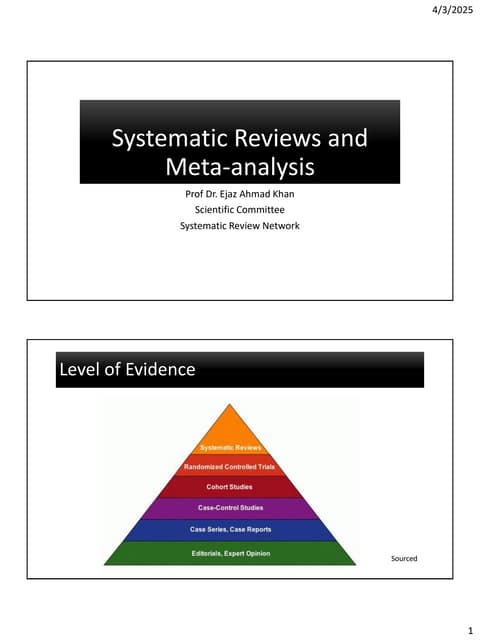



Introduction to Systematic Reviews - Prof Ejaz KhanSystematic Reviews Network (SRN)
Ėý
A Systematic Review:
Provides a clear and transparent process
âĒ Facilitates efficient integration of information for rational decision
making
âĒ Demonstrates where the effects of health care are consistent and
where they do vary
âĒ Minimizes bias (systematic errors) and reduce chance effects
âĒ Can be readily updated, as needed.
âĒ Meta-analysis can provide more precise estimates than individual
studies
âĒ Allows decisions based on evidence , whole of it and not partialCoding Guide Handout
- 1. Coding Guide<br />Do not code the introductory instructions. Start coding when the moderator commences activity #1.<br />On the coding form, youâll see a column for both ânotesâ and âcoder notes.â Notes are your rich description of what happened around the time of the time stamp. Make clear why you attached the code you did and anything else important. Coder notes are for you to note something you think is especially important â something you want to ensure that is not lost in future analysis.<br />If you want to suggest an additional code, give it code âZâ and explain in the coder notes column your suggestion for an additional code.<br />Verbal ABCDEFGHIJPositive CommentNegative CommentRationale Comment (statement about why they are doing something)Suggestion for ImprovementVariation from ExpectationQuestion (subject asks a question; do not code for subject restatement of question to themselves)Stated Confusion/UncertaintyStated FrustrationStated ConfidenceStated SatisfactionNon-VerbalKLMNOPFrowning/Grimacing/Groaning/UnhappySmiling/Laughing/HappySurprised/Unexpected (e.g. widened eyes, tilted head, shrug)Concentration (e.g. squinting, furrowed brow)Impatience (e.g. eye-rolling, impatient sighing or tapping, fidgeting)Evidence of Confusion/Uncertainty Task Completion StatusQRSTUVIncompleteParticipant gave upTask called by moderator FailDK (failed but did not know it) CompleteFully completePartially completeSuccessDK (Success but didnât know it. For example, on Q2, subject is looking at a swine flu article citation on screen but does not realize that they have the answer.)<br />



